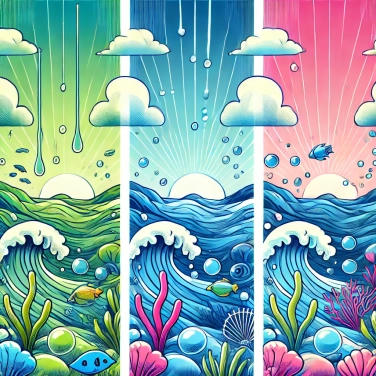The oceans have different salinity levels due to various factors such as evaporation, precipitation, inputs of fresh water from rivers, and ocean currents.

The salinity of the oceans depends too much on the climate to be uniform. When it’s very hot, evaporation speeds up significantly, leaving the salt concentrated in the water that remains in place. As a result, in warm and sunny regions, like near the equator or in the Mediterranean, the sea is often a bit saltier than average. Conversely, where rain falls generously (like at high latitudes or near the equator during the wet season), all that fresh water dilutes the ambient salinity. Another factor: the freezing of polar areas plays its role. When water freezes, it leaves most of the salt in the surrounding water, making the adjacent ocean even saltier. On the other hand, when the ice melts in the warm season, it releases fresh water that slightly lowers the local salinity. The result? Depending on where you dip your head, it might not sting the same way.
Rivers play a significant role in the salinity of the oceans. When they flow into the sea, they bring large amounts of freshwater, thereby locally decreasing the concentration of salt. As a result, near the estuaries, the water is often less salty. In contrast, hydrothermal vents, these types of underwater chimneys on the ocean floor, release dissolved minerals (iron, magnesium, sulfur...) from the depths of the Earth. This locally increases the salinity of the water. These two phenomena create quite marked salinity contrasts depending on the oceanic areas.
Ocean currents constantly move huge amounts of water across the oceans, thus creating exchanges between more or less salty areas. For example, the famous Gulf Stream, which flows towards the North Atlantic, carries warm, salty water from the tropics to the colder regions in the north. As a result, it significantly modifies local salinity levels. Conversely, cold, deep currents, like those circulating in Antarctica, transport colder and generally less salty water, which helps balance saline concentrations differently in certain locations. These ongoing exchanges of water play a crucial role in distributing salinity on a global scale, preventing some areas from becoming too salty or too little so.
Oceanic geography strongly influences salinity variations around the world. For example, in the Mediterranean, a semi-closed sea, intense evaporation and limited exchange with the Atlantic Ocean cause a significant rise in salinity. In contrast, deep water regions, such as ocean trenches, accumulate very salty waters at depth because they are denser and naturally sink below less salty water layers. These deep areas act as salt reservoirs, gradually influencing overall salinity through slow but powerful underwater currents known as bottom currents. Underwater geographical barriers (such as underwater mountain ranges or ridges) also modulate the distribution of salt by restricting water exchange between different parts of the ocean.
Places where it is particularly hot often experience intense evaporation, causing water to escape and leaving behind more salt. As a result, areas like the Red Sea or the Mediterranean have much saltier water than other cooler ocean regions. Conversely, when it rains frequently, all the fresh water added by the rain reduces the local salinity. Thus, regions near the equator, where precipitation can be super abundant, generally have lower salinity levels. Storms or strong winds also play their part by mixing the water layers, which can temporarily alter the salt levels observed locally.
Hydrothermal vents on the ocean floor release minerals and dissolved salts that locally influence salinity, creating specific conditions for rich and unique ecosystems.
Evaporation plays a crucial role in determining salinity levels: intense evaporation, such as that found in the Mediterranean, can lead to high salt concentration.
Did you know that the Atlantic Ocean is generally saltier than the Pacific Ocean? This is partly explained by the differences in evaporation and the balance of precipitation between these two oceans.
The Dead Sea is one of the saltiest bodies of water in the world, containing about 9 times more salt than ordinary oceans; this high salinity virtually prevents any aquatic life from developing there.
Not necessarily, as the regular input of salt from rivers and geological activity is balanced by natural removal mechanisms such as chemical precipitation, salt exchanges with ocean floors, or the formation of salt deposits.
Yes, some oceans or marine areas, particularly in polar regions or around the mouths of large rivers, have lower salinity, mainly due to the significant input of fresh water from glacier melting or abundant precipitation.
Yes, it is possible to make seawater potable through processes such as desalination, primarily via reverse osmosis or thermal distillation, in order to separate the salt from the water and thus make it safe for human consumption.
Absolutely, salinity is a determining factor for marine ecosystems. Each marine species has a specific threshold of salinity adaptation. If salinity changes suddenly or persistently, it can significantly impact biodiversity and the distribution of marine organisms.
The Dead Sea has a very high salinity due to intense evaporation combined with a lack of drainage into the oceans. Thus, when the water evaporates, it leaves behind the accumulated mineral salts, significantly increasing the salt concentration.

0% of respondents passed this quiz completely!
Question 1/5